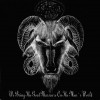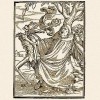Atom Symbol Patch
Patch made by Depressive Illusions Records.
An atom is the smallest constituent unit of ordinary matter that has the properties of a chemical element. Every solid, liquid, gas, and plasma is composed of neutral or ionized atoms. Atoms are extremely small; typical sizes are around 100 picometers (1×10−10 m, a ten-millionth of a millimeter, or 1/254,000,000 of an inch). They are so small that accurately predicting their behavior using classical physics – as if they were billiard balls, for example – is not possible. This due to quantum effects. Current atomic models now use quantum principles to better explain and predict this behavior.
Every atom is composed of a nucleus and one or more electrons bound to the nucleus. The nucleus is made of one or more protons and a number of neutrons. Only the most common variety of hydrogen has no neutrons. Protons and neutrons are called nucleons. More than 99.94% of an atom's mass is in the nucleus. The protons have a positive electric charge
whereas the electrons have a negative electric charge. The neutrons
have no electric charge. If the number of protons and electrons are
equal, then the atom is electrically neutral. If an atom has more or
fewer electrons than protons, then it has an overall negative or
positive charge, respectively. These atoms are called ions.
The electrons of an atom are attracted to the protons in an atomic nucleus by the electromagnetic force. The protons and neutrons in the nucleus are attracted to each other by the nuclear force.
This force is usually stronger than the electromagnetic force that
repels the positively charged protons from one another. Under certain
circumstances, the repelling electromagnetic force becomes stronger than
the nuclear force. In this case, the nucleus shatters and leaves behind different elements. This is a kind of nuclear decay. All electrons, nucleons, and nuclei alike are subatomic particles. The behavior of electrons in atoms is closer to a wave than a particle.
The number of protons in the nucleus, called the atomic number, defines to which chemical element the atom belongs. For example, each copper atom contains 29 protons. The number of neutrons defines the isotope of the element. Atoms can attach to one or more other atoms by chemical bonds to form chemical compounds such as molecules or crystals. The ability of atoms to associate and dissociate is responsible for most of the physical changes observed in nature. Chemistry is the discipline that studies these changes.
See also
|
6.99€
Tape |
10.00€
Vinyl, 7" |
5.99€
Merchandise |
5.99€
Merchandise |
7.15€
CD-R |
|
6.99€
Tape |
9.00€
CD |
8.00€
CD |
7.99€
Tape |
7.99€
Tape |









